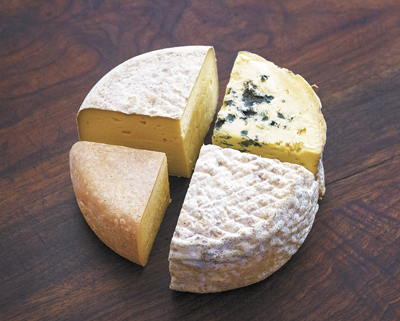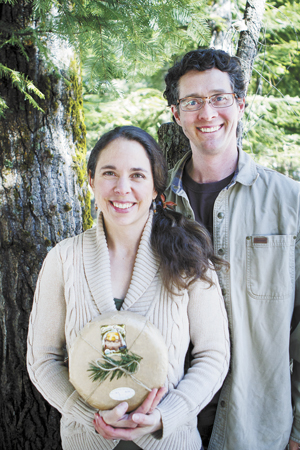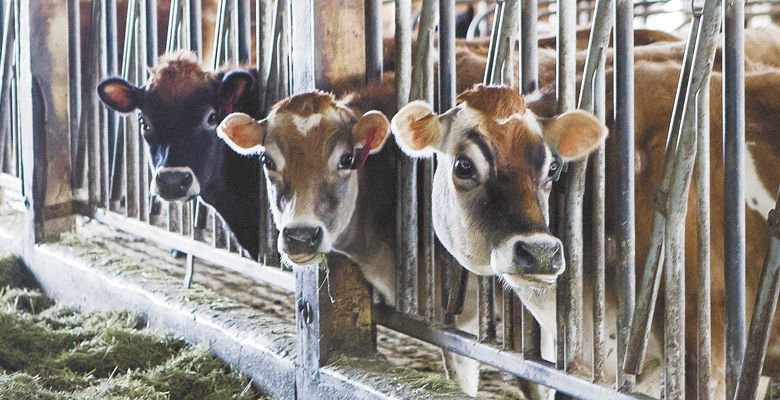For the Lava Cheese
Trout Lake creamery exploding onto artisan scene
If you’ve been paying attention to the ever-evolving cheese scene here in the Northwest, you may have noticed the surge of creameries opening in Washington over the past few years. There are now more than 70 licensed cheesemakers in the state — almost triple the number operating in Oregon. Talk about a modern-day dairy renaissance.

One of the stars shining up north is Cascadia Creamery, a six-year-old company started by John and Marci Shuman, a husband-and-wife team who make mouth-wateringly delicious certified-organic, raw-milk cheeses that have sky-rocketed in popularity — they’ve been featured on the Food Network, in The Seattle Times and throughout other media.
Located in the scenic, rural town of Trout Lake, Cascadia is only 20 miles north of Hood River. The Shumans eventually were tired of their urban life in Portland and, as they began to consider parenthood, made the conscious choice to relocate to a small town.
Trout Lake was on their list to explore after John discovered it while hiking the nearby Pacific Crest Trail. The couple was also attracted by the idyllic, close-knit town.
“I wanted to be one with the community, economically and socially, not coming in as an outsider, not trying to make this into Portland,” John said.
The area is known for two markets: dairy and managed timber. Soon, John was apprenticing at a local dairy, learning all he could, He traded labor in exchange for milk from which he began to develop the early recipes for the cheeses he would later make commercially.
The couple constructed a cozy log home and, a number of years later, built a micro-creamery and man-made cave adjacent to their home. At first, the idea was to remain small, selling cheese to locals at farmers’ markets in Trout Lake and Hood River.
But the cheese would not stay undiscovered for long. An early customer was a local specialty food distributor who introduced John and his cheeses to the Portland market. Orders soon began rolling in from small cheese shops to regional and national chains.
Though the original idea was to operate a farmstead creamery, a strong partnership emerged between Cascadia Creamery and the fourth-generation dairy — one of the first in the state certified organic by Oregon Tilth. The resulting milk comes from Jersey, Dutch Belted and Friesian heritage breeds — known for their longer, healthier lives compared with others — grazing on grass grown in pure volcanic soil.
One day, while out in the pasture observing the herd, Shuman discovered a small hole in the ground out of which cool air was blowing. He dropped a temperature gauge inside and discovered readings of 53°F and 92 percent humidity: perfect for aging cheese.

The area around Trout Lake is famous for its unusual underground lava tubes. Settlers who arrived in the 1880s and their descendants used these natural caves to store everything from ice to potatoes to aging cheese. Yes, Cascadia is not the first creamery in town; the Guler Cheese Company aged a Roquefort-style blue cheese on Cheese Cave Road for a time between the early 1940s and mid-1950s — the business dissolved following a messy divorce.
More than a half-century later, the Shumans are nearing completion on their nearly 5,000-square-foot facility, which includes space for production, packaging, fulfillment and office work, plus aging in the cool caves. Beneath the facility, a lava tube has been transformed into a state-of-the-art, food-safe aging environment.
“We wanted to find a way to use that underground resource with modern day sanitation standards while still having a living, breathing cave that could birth a cheese reflective of the local land,” John explained.
Look or ask for Cascadia’s locally inspired names at your favorite specialty cheese shop. The stinky — but not too stinky — smear-rinded cheese Sawtooth is named for the famous berry fields; the aged and beautifully presented Sleeping Beauty refers to a native legend and local rock formation; the delicate, tangy and soft-rinded Cloud Cap was inspired by the regular coating of clouds that adorn the top of nearby Mount Adams; and Glacier Blue is aptly named as its blue veins are reminiscent of glacial lakes.
One of the hallmarks of Cascadia’s cheeses is their approachability: delicious, well-aged and unique but not so “out there” that they put off more mainstream tastes. The cheeses are noteworthy and can easily be the star of a cheese plate.
A complex white with a hint of sweetness and nice balance of acidity would be an excellent companion if you are drinking white. A fruit-forward, easy-on-the-tannins red also would pair perfectly.
Find Cascadia Creamery cheeses at most independent cheese shops, New Seasons and Market of Choice. For more information, visit www.cascadiacreamery.com.











